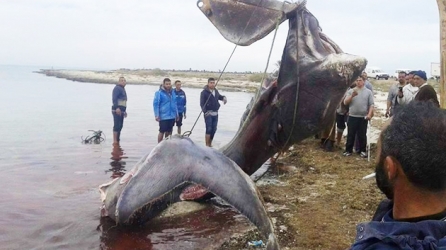Search
02/16: A 10m length basking shark stranded in Djerba
A shark with a total length of ten meters and weighing about a ton, was found stranded on February 22, 2016 in the region of Ajim Djerba in southern Tunisia.
According to Mr M.N. Bradai, Senior Research Fellow at the National Institute of Science and Technology of the Sea (Tunisia), it is a basking shark Cetorhinus maximus (Gunnerus 1765), the largest living shark in the Mediterranean. Some specimens reach 12 m of total length. This species filter the water near the surface to feed on plankton and other microscopic organisms and would therefore be harmless to humans.
The basking shark is a migratory species. In the Mediterranean, it is observed mostly in the western basin, with seasonal variability (Mancusi et al, 2005). In Tunisia, five catches in fishing nets were reported in the literature between 1992 and 2001:
- In 1992, a female of 7.10 m was taken in floating gill nets off the Skhira in the Gulf of Gabes, by 12 m deep (Bradaï & Ghorbel, 1992).
- In the Gulf of Tunis, off Ras Jebel, Rais & BACCAR (1998) reported a trammel capture of a male with a total length of 7.15 m.
- In 1999, a male with a total length of 7.37 m was discovered in trammel nets at Sidi Msarra, a close locality of Ellouza, by 3 m deep not far from a shrimp tank.
- In 2000, an individual was captured with trammel nets off Salakta, north of the Gulf.
- In 2001, a specimen was caught in the purse seine in the Gulf of Gabes, its total length reached 4.25 m (Capapé et al., 2003).
Fishing is one of the most important threats to the survival of basking sharks, both regionally and globally. When they are not accidentally caught in fishing nets, sharks are caught intentionally for its fins, prized in international trade (Fowler, S. L. 2005).
Compagno (1984) considers this species of shark "to be extremely vulnerable to overfishing, perhaps more than most sharks, ...ascribed to its slow growth rate, lengthy maturation time, long gestation period, probably low fecundity and probably the small size of existing populations (clashed with the huge size of individuals in their small schools)".
The basking shark is protected by law in some countries and by international conventions. It is especially listed in Annex II to the Protocol Concerning Specially Protected Areas and Biological Diversity in the Mediterranean (SPA / BD) as an endangered or threatened species, and in Appendix II of the Convention on International Trade in Endangered Species of Wild Fauna and Flora (CITES).
Within the Barcelona Convention, a program was set up in 2003, and updated in 2013, to protect all sharks and cartilaginous fish in the Mediterranean. It provides notably for the use of existing protocols and assessment forms (RAC / SPA, FAO) of specific data on landings, discards and observations of threatened species.
View photos of the basking shark found in Tunisia on jawharafm.net (local media)
To know more :
- MANCUSI, C., CLÒ, S., AFFRONTE, M., BRADAÏ, M. N., HEMIDA F., SERENA, F., SOLDO, A., VACCHI, M., 2005. On the presence of basking shark (Cetorhinus maximus) in the Mediterranean Sea. Cybium 2005, 29(4): 399-405. https://edesabata.files.wordpress.com/2008/01/cetorino-mancusi-cybium.pdf
- BRADAÏ, M. N., SAÏDI, B., GHORBEL, M., BOUAÏN, A., GUÉLORGET, O., CAPAPÉ, C., 2002. Observations sur les requins du golfe de Gabès (Tunisie méridionale, Méditerranée centrale). Mésogée Volume 60|2002 http://www.museum-marseille.org/mesogee-60-2002-pass.pdf
- Fowler, S.L. 2005. Cetorhinus maximus. The IUCN Red List of Threatened Species 2005: e.T4292A10763893. http://dx.doi.org/10.2305/IUCN.UK.2005.RLTS.T4292A10763893.en




Find Us On...